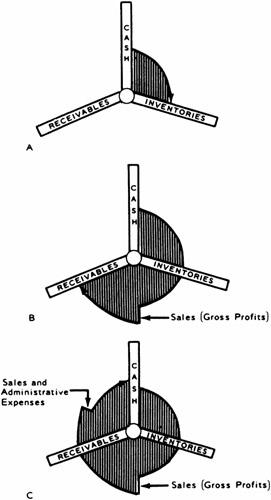Applying the Circulating Capital Principle
|
Profit is made by the circulation of business capital. Every business is founded on capital or funds that start in the form of cash. The objective of business is to make the initial cash grow into more cash. This is accomplished by circulating the capital, the initial cash, through three transfer points. Each transfer adds value:
-
The initial cash circulates first into inventories.
-
Then the inventories circulate into receivables.
-
The receivables finally circulate back into cash, completing one cycle.
This three-step process demonstrates the principle of circulating capital. Every business depends on it for its income.
Circulating capital is the current assets of a business. They go to work in profitmaking as soon as cash is invested in accumulating inventories. Every time raw materials are purchased or processed, inventories come into existence. Another name for production scheduling could really be inventory conversion. Manufacturing adds further to the value of inventories, and so do all the other processing functions of a business that transfer value from cash to product costs on a dollar-for-dollar basis.
Figure 8-1 shows the profitmaking process that occurs as capital funds circulate through a customer's business. At A the funds are in the form of cash. As the business operates, the funds change form. The initial cash is transferred into inventories as raw materials are purchased, labor is paid, and finished goods are manufactured and transported from plant to warehouse.

Figure 8-1: Profitmaking capital circulation.
When sales occur at B, funds flow from inventories—the manufactured goods—into receivables. As they flow, the magnitude of the funds increases because inventories are valued at cost and receivables are valued at selling price. This increase represents the gross profit on sales. The greater the gross profit rate, the greater the increase in funds during each rotation of the capital circulation cycle.
At C, the funds earned by the collection of receivables flow back once again into cash. Before they do, they are reduced by the sales and administrative expenses that have been disbursed throughout the operating cycle.
At this point, one full cycle of capital circulation has been completed. It has resulted in an increase in the number of dollars in the circulating capital fund. This increase is the difference between gross profits and selling/administrative expenses. In other words, a profit is made when the circulating capital of the business turns over one cycle. The more cycles through which you can help turn your customer's circulating capital during an operating year, the greater the profit the customer can earn. This is the principle of turnover.
|
EAN: 2147483647
Pages: 105
- A View on Knowledge Management: Utilizing a Balanced Scorecard Methodology for Analyzing Knowledge Metrics
- Technical Issues Related to IT Governance Tactics: Product Metrics, Measurements and Process Control
- Managing IT Functions
- Governing Information Technology Through COBIT
- Governance Structures for IT in the Health Care Industry